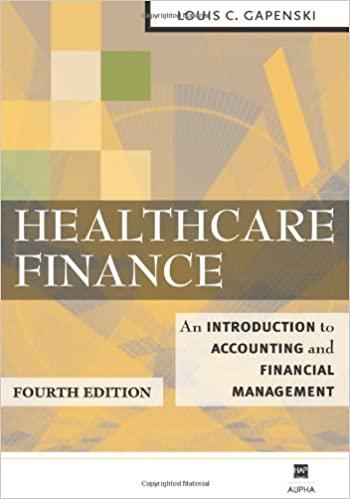Question
QUESTION 1 A $150,000 loan is to be amortized over 7 years, with annual end-of-year payments. Which of these statements is CORRECT? a. The proportion
QUESTION 1
-
A $150,000 loan is to be amortized over 7 years, with annual end-of-year payments. Which of these statements is CORRECT?
a. The proportion of interest versus principal repayment would be the same for each of the 7 payments.
b. The proportion of each payment that represents interest versus repayment of principal would be higher if the interest rate were higher.
c. The proportion of each payment that represents interest as opposed to repayment of principal would be higher if the interest rate were lower.
d. The annual payments would be larger if the interest rate were lower.
e. If the loan were amortized over 10 years rather than 7 years, and if the interest rate were the same in either case, the first payment would include more dollars of interest under the 7-year amortization plan.
QUESTION 2
-
As a result of compounding, the effective annual rate on a bank deposit (or a loan) is always equal to or less than the nominal rate on the deposit (or loan).
True
False
QUESTION 3
-
Which of the following statements is CORRECT?
a. Time lines are not useful for visualizing complex problems prior to doing actual calculations.
b. Time lines cannot be constructed to deal with situations where some of the cash flows occur annually but others occur quarterly.
c. A time line is not meaningful unless all cash flows occur annually.
d. Time lines can only be constructed for annuities where the payments occur at the end of the periods, i.e., for ordinary annuities.
e. Time lines can be constructed where some of the payments constitute an annuity but others are unequal and thus are not part of the annuity.
QUESTION 4
-
Which of the following statements is CORRECT?
a. The cash flows for an annuity must all be equal, and they must occur at regular intervals, such as once a year or once a month.
b. If some cash flows occur at the beginning of the periods while others occur at the ends, then we have what the textbook defines as avariable annuity.
c. The cash flows for an annuity due must all occur at the ends of the periods.
d. The cash flows for an ordinary (or deferred) annuity all occur at the beginning of the periods.
e. If a series of unequal cash flows occurs at regular intervals, such as once a year, then the series is by definition an annuity.
QUESTION 5
-
All other things held constant, the present value of a given annual annuity decreases as the number of periods per year increases.
True
False
QUESTION 6
-
A time line is meaningful even if all cash flows do not occur annually.
True
False
QUESTION 7
-
Which of the following statements is CORRECT?
a. Time lines are not useful for visualizing complex problems prior to doing actual calculations.
b. A time line is not meaningful unless all cash flows occur annually.
c. Time lines cannot be constructed in situations where some of the cash flows occur annually but others occur quarterly.
d. Some of the cash flows shown on a time line can be in the form of annuity payments, but none can be uneven amounts.
e. Time lines can be constructed for annuities where the payments occur at either the beginning or the end of the periods.
QUESTION 8
-
Which of the following statements is CORRECT?
a. The present value of a 3-year, $150 ordinary annuity will exceed the present value of a 3-year, $150 annuity due.
b. If a loan or investment has annual payments, then the effective, periodic, and nominal rates of interest will all be different.
c. The proportion of the payment that goes toward interest on a fully amortized loan increases over time.
d. An investment that has a nominal rate of 6% with semiannual payments will have an effective rate that is smaller than 6%.
e. If a loan has a nominal annual rate of 8%, then the effective rate will never be less than 8%.
QUESTION 9
-
Assume that you own an annuity that will pay you $15,000 per year for 12 years, with the first payment being made today. You need money today to start a new business, and your uncle offers to give you $128,000 for the annuity. If you sell it, what rate of return would your uncle earn on his investment?
a. 5.73%
b. 6.91%
c. 5.32%
d. 8.36%
e. 6.77%
QUESTION 10
-
You are considering two equally risky annuities, each of which pays $5,000 per year for 10 years. Investment ORD is an ordinary (or deferred) annuity, while Investment DUE is an annuity due. Which of the following statements is CORRECT?
a. The present value of ORD exceeds the present value of DUE, while the future value of DUE exceeds the future value of ORD.
b. If the going rate of interest decreases from 10% to 0%, the difference between the present value of ORD and the present value of DUE would remain constant.
c. The present value of ORD exceeds the present value of DUE, and the future value of ORD also exceeds the future value of DUE.
d. A rational investor would be willing to pay more for DUE than for ORD, so their market prices should differ.
e. The present value of DUE exceeds the present value of ORD, while the future value of DUE is less than the future value of ORD.
Step by Step Solution
There are 3 Steps involved in it
Step: 1

Get Instant Access to Expert-Tailored Solutions
See step-by-step solutions with expert insights and AI powered tools for academic success
Step: 2

Step: 3

Ace Your Homework with AI
Get the answers you need in no time with our AI-driven, step-by-step assistance
Get Started


